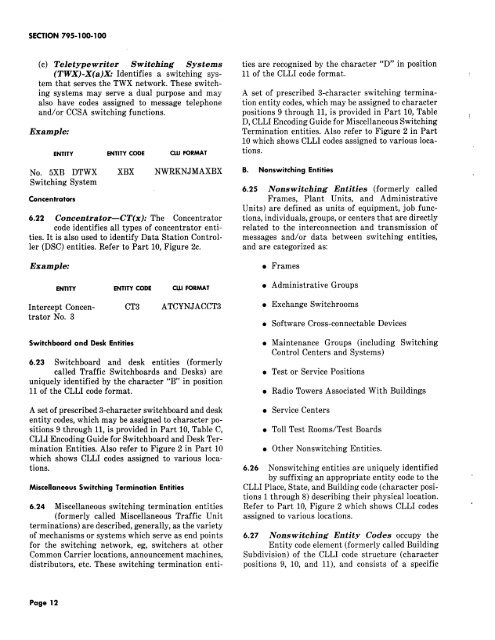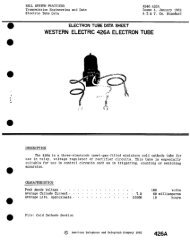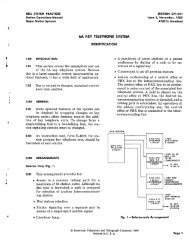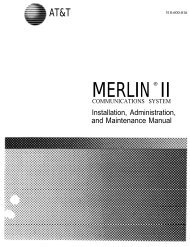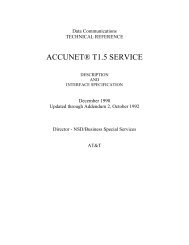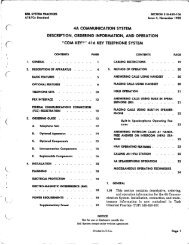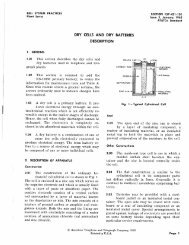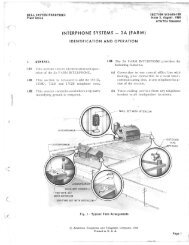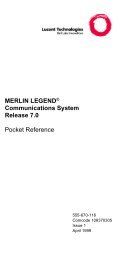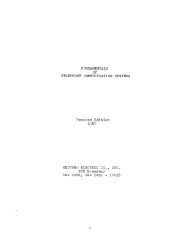COMMON LANGUAGE LOCATION IDENTIFICATION (CLLI) CODE ...
COMMON LANGUAGE LOCATION IDENTIFICATION (CLLI) CODE ...
COMMON LANGUAGE LOCATION IDENTIFICATION (CLLI) CODE ...
You also want an ePaper? Increase the reach of your titles
YUMPU automatically turns print PDFs into web optimized ePapers that Google loves.
SECTION 795-1 00-100<br />
(c) Teletypewriter Switching Systems<br />
(TWX)-X(a)X: Identifies a switching system<br />
that serves the TWX network. These switching<br />
systems may serve a dual purpose and may<br />
also have codes assigned to message telephone<br />
and/or CCSA switching functions.<br />
Example:<br />
ENTITY ENTITY <strong>CODE</strong> <strong>CLLI</strong> FORMAT<br />
No. 5XB DTWX XBX NWRKNJMAXBX<br />
Switching System<br />
Concentrators<br />
6.22 Concentrator-CT(x): The Concentrator<br />
code identifies all types of concentrator entities.<br />
It is also used to identify Data Station Controller<br />
(DSC) entities. Refer to Part 10, Figure 2c.<br />
Example:<br />
ENTITY<br />
Intercept Concentrator<br />
No. 3<br />
Switchboard and Desk Entities<br />
ENTITY <strong>CODE</strong> CIJ.I FORMAT<br />
CT3 ATCYNJACCT3<br />
6.23 Switchboard and desk entities (formerly<br />
called Traffic Switchboards and Desks) are<br />
uniquely identified by the character "B" in position<br />
11 of the <strong>CLLI</strong> code format.<br />
A set of prescribed 3-character switchboard and desk<br />
entity codes, which may be assigned to character positions<br />
9 through 11, is provided in Part 10, Table C,<br />
<strong>CLLI</strong> Encoding Guide for Switchboard and Desk Termination<br />
Entities. Also refer to Figure 2 in Part 10<br />
which shows <strong>CLLI</strong> codes assigned to various locations.<br />
Miscellaneous Switching Termination Entities<br />
6.24 Miscellaneous switching termination entities<br />
(formerly called Miscellaneous Traffic Unit<br />
terminations) are described, generally, as the variety<br />
of mechanisms or systems which serve as end points<br />
for the switching network, eg, switchers at other<br />
Common Carrier locations, announcement machines,<br />
distributors, etc. These switching termination enti-<br />
Page 12<br />
ties are recognized by the character "D" in position<br />
11 of the <strong>CLLI</strong> code format.<br />
A set of prescribed 3-character switching termination<br />
entity codes, which may be assigned to character<br />
positions 9 through 11, is provided in Part 10, Table<br />
D, <strong>CLLI</strong> Encoding Guide for Miscellaneous Switching<br />
Termination entities. Also refer to Figure 2 in Part<br />
10 which shows <strong>CLLI</strong> codes assigned to various locations.<br />
B. Nonswitching Entities<br />
6.25 Nonswitching Entities (formerly called<br />
Frames, Plant Units, and Administrative<br />
Units) are defined as units of equipment, job functions,<br />
individuals, groups, or centers that are directly<br />
related to the interconnection and transmission of<br />
messages and/or data between switching entities,<br />
and are categorized as:<br />
• Frames<br />
• Administrative Groups<br />
• Exchange Switchrooms<br />
• Software Cross-connectable Devices<br />
• Maintenance Groups (including Switching<br />
Control Centers and Systems)<br />
• Test or Service Positions<br />
• Radio Towers Associated With Buildings<br />
• Service Centers<br />
• Toll Test Rooms/Test Boards<br />
• Other Nonswitching Entities.<br />
6.26 Nonswitching entities are uniquely identified<br />
by suffixing an appropriate entity code to the<br />
<strong>CLLI</strong> Place, State, and Building code (character positions<br />
1 through 8) describing their physical location.<br />
Refer to Part 10, Figure 2 which shows <strong>CLLI</strong> codes<br />
assigned to various locations.<br />
6.27 Nonswitching Entity Codes occupy the<br />
Entity code element (formerly called Building<br />
Subdivision) of the <strong>CLLI</strong> code structure (character<br />
positions 9, 10, and 11), and consists of a specific


